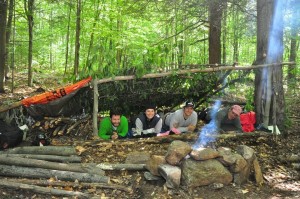Making a proper survival shelter
In the featured picture a lean-to survival shelter has been constructed in a survival training class apparently in Europe. I am making some assumptions here, but this picture is one of many showing accomplishments of the class. Over the years I have seen hundreds of pictures of survival training shelters – that are worthless. If you are going to hack down natural resources to make a shelter at least make the shelter, a shelter. I’m not at all against using natural materials, but don’t waste them for a photo op. If harvesting live materials for practice, I like to gather from a wide area so I am only doing a light pruning here and there. In a real situation you would not want to waste calories and would take whatever is closest.
Let’s examine the picture as an example to cover the subject of building a proper shelter. Here is a list of my comments of the survival shelter as shown.
- The roof angle is only 30° – 45° while 60° is more of a minimum slope for a natural roof
- Thatching on the roof is useless, you can see through it all over. Perhaps it’s for shade only? Probably not for at least two reasons, 1) the forest seems plenty thick to provide shade on its own, 2) notice the woodpile on the left is covered with a tarp to protect from the rain.
- The woodpile would likely be dry while the people would be soaked in a rain. They’re all smiles now, how about that 1 am thunderstorm?
- The leaves of the thatching are hanging down meaning that any water will follow the branch and leaf stem then on down to the tip where it will drip onto the occupants below.
- The shelter does not appear to be deep enough if those pictured are to be protected. Feet seem to be at the bottom of the roof and the front edge is little if any farther out than their heads.
- Back packs are outside the shelter unprotected.
- If a storm were during the day and/or were extended in duration the shallow roof height means the only option they have is to lay down all the time. Making meals, writing in a journal, or doing other tasks would be very difficult without being able to at least sit up comfortably.
This shelter would be marginal even with a tarp as a cover over the woodwork frame as the roof is too low and the roof slope should really be greater. Many times people assume a shelter is only for sleeping in, while we all know that it rains in the daytime as well as at night. A proper shelter should provide protection, comfort, and ability of occupants to perform many tasks including meal preparation.
To create the proper survival shelter – Before doing anything, determine the purposes of the shelter, the needs the shelter must provide.
- Determine the primary purpose of the shelter
- List the needs the shelter must provide
- Decide how large the shelter must be for the number of people and gear
- Will the shelter need to be used for meal preparation?
- Orient the shelter to protect against storm direction
- Make sure to set up bedding so that there is enough comfort for a full night’s sleep
These are just a few points to consider in sheltering. I have seen so many wholly inadequate shelters built, all with happy smiling faces of the builders, unknowing the discomfort that awaits them should a storm arise.
Of course the easiest way to shelter is if you have a tarp like our PST or PSTL (Personal Survival Tarp), or even our PSS/PSSL Poncho (Personal Survival Shelter) set up, or some kind of tent. These are quick, easy and effective. However even with these conveniences the shelter must be set up correctly.
Until next time this is Perry Peacock, “Simplifying Survival”




